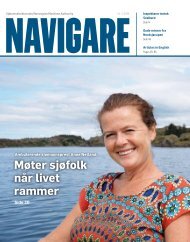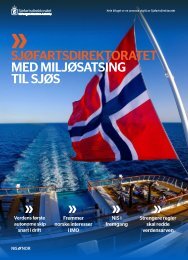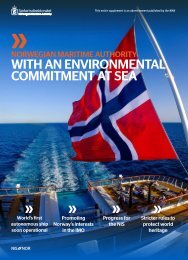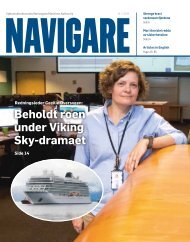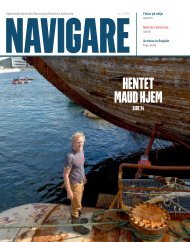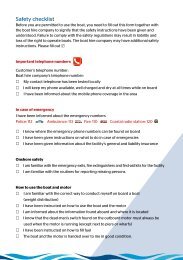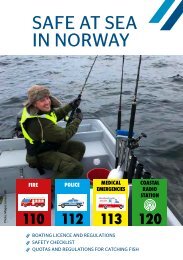Create successful ePaper yourself
Turn your PDF publications into a flip-book with our unique Google optimized e-Paper software.
news<br />
english translation from page 14 english translation from page 18<br />
Seafarers on vessels of 8<br />
metres in length and upwards:<br />
New competence<br />
requirements<br />
delayed<br />
The introduction of new requirements for<br />
qualifications and certificates for<br />
seafarers on cargo vessels of 8 metres in<br />
overall length and upwards has been<br />
delayed. After two consultations on<br />
proposed Regulations, it has proved<br />
difficult to draw up a set of rules which<br />
can be adapted to the many different<br />
actors in the vessel group.<br />
The last draft was circulated for review in August<br />
2<strong>01</strong>8 with a deadline for comments on 24<br />
October. The Norwegian Maritime Authority<br />
(NMA) received a number of statements from<br />
several actors that would have been affected by<br />
the regulatory amendments.<br />
“Many have expressed a concern that the<br />
proposed requirements could have far-reaching<br />
consequences and major disadvantages to them,”<br />
says Håvard Gåseidnes, who is Head of Unit for<br />
Recreational Craft in the NMA. He explains that<br />
the process of finding a solution which is both<br />
appropriate and adapted to the needs of the<br />
industry has been very difficult.<br />
“The NMA will therefore enter into dialogue<br />
with the consultative bodies this spring in order to<br />
map the various needs and challenges expressed in<br />
the consultative statements. As a consequence,<br />
new proposed Regulations will be circulated for<br />
review in the second quarter of this year at the<br />
earliest,” says Gåseidnes.<br />
Consultative statements from the first<br />
consultation in the autumn of 2<strong>01</strong>7 demonstrated<br />
that large parts of the industry believed that the<br />
biggest challenge would be to satisfy the seagoing<br />
service requirement. This was particularly the case<br />
for vessels used by authorities and non-profit<br />
organisations. The NMA claims to have taken this<br />
into account in the new proposed Regulations<br />
from 2<strong>01</strong>8.<br />
However, these latest proposed new<br />
qualification requirements raised many of the<br />
same objections that emerged during the first<br />
consultation.<br />
When shipwrecks occur,<br />
immediate assistance is needed<br />
The Arctic is an inhospitable place. When misfortune strikes, time is<br />
of the essence. Today’s emergency preparedness is insufficient.<br />
Jon magnus Haga, Director of the Norwegian Centre for Maritime Medicine<br />
The Christmas break was a dramatic time<br />
for a shrimp trawler in the Hinlopen Strait<br />
in the north of Svalbard. In pitch-darkness,<br />
snowdrift and high wind, the MS<br />
‘Northguider’ ran aground. The damage<br />
was extensive, and the vessel took on water.<br />
The crew of 14 soon had to give in and<br />
prepare to abandon ship.<br />
More than 20 000 Norwegians work at<br />
sea, many of them in polar regions. Cargo<br />
is carried across the Arctic Ocean. Catches<br />
of fish, shrimp and crab are worth billions<br />
of kroner. Cruise vessels venture further<br />
and further north. More than 80 per cent<br />
of all shipping in the Arctic passes through<br />
Norwegian territorial waters. This activity is<br />
profitable for Norway. The value of the<br />
catches of white fish alone was equal to the<br />
annual operating cost of Norway’s secondlargest<br />
hospital, Haukeland University<br />
Hospital.<br />
The Arctic is an inhospitable wilderness.<br />
Darkness reigns for six months of the year,<br />
the ambient temperature is low and the<br />
weather changes quickly. This harsh climate<br />
presents challenges to safe navigation. Polar<br />
depressions can wreck vessels. Sea ice can<br />
crush hulls. The climate also affects work<br />
upwind. Cold air can easily cause frostbite.<br />
Cold water quickly causes hypothermia.<br />
Poor visibility, rain and heavy seas increase<br />
the likelihood of error.<br />
Through its Polar Code, the IMO has<br />
defined requirements for safety equipment<br />
to be used during voyages in polar regions.<br />
These requirements are stricter than those<br />
applied in more southerly waters, but<br />
cannot offset the risk. A study<br />
commissioned by the ‘Maritime Forum’ in<br />
Svalbard in the summer of 2<strong>01</strong>6 suggests<br />
that the safety equipment does not measure<br />
up. The expected survival time of healthy<br />
volunteers clad in survival suits on board a<br />
rescue raft proved to decline dramatically<br />
after no more than 12 hours at sea – on a<br />
sunny day. Their endurance through a<br />
winter storm is likely to be far shorter.<br />
The sailor’s only hope is that someone<br />
will come to his or her rescue – quickly. In<br />
polar regions, time is of the essence more<br />
than anywhere else.<br />
In 2<strong>01</strong>1, the eight member countries in<br />
the Arctic Council signed a collaboration<br />
agreement on search and rescue in the<br />
Arctic. Norway committed to cover a sector<br />
that reaches from the Norwegian mainland<br />
through the Barents Sea and up to the Pole.<br />
The Coast Guard and the Governor of<br />
Svalbard were assigned key roles in<br />
emergency preparedness.<br />
The distances across the Arctic Ocean<br />
are wide. When the emergency call from<br />
the MS ‘Northguider’ was sent, no other<br />
vessels were nearby. The nearest Coast<br />
Guard vessel, the KV ‘Barentshav’, was on<br />
patrol south of Bjørnøya island, more than<br />
24 hours away. The Governor’s vessel, MS<br />
‘Polarsyssel’, was laid up for the winter in<br />
Sunnmøre.<br />
Fortunately, the disabled vessel was so<br />
close to Longyearbyen that the Governor’s<br />
two Super Puma helicopters could reach it.<br />
The rescue operation was dramatic, verging<br />
on the impossible. This time, the entire<br />
crew was rescued, safe and sound. Next<br />
time, we may not be so lucky.<br />
The current emergency preparedness<br />
situation in the North is indefensible. There<br />
is incongruity between the risk and the<br />
availability of resources for search and<br />
rescue. There is also a discrepancy between<br />
the amount of value which is created in the<br />
Arctic and the resources that society<br />
allocates. Why do the Governor’s finances<br />
not allow for year-round operation of the<br />
MS ‘Polarsyssel’? Why does the Coast<br />
Guard have its number of vessels curtailed?<br />
Why has the Coast Guard gone without<br />
operative helicopters since 2<strong>01</strong>4?<br />
We cannot lose any of our sailors. It is<br />
therefore crucial that we continue to<br />
question the politicians.<br />
60 | <strong>Navigare</strong> 1 - 2<strong>01</strong>9










